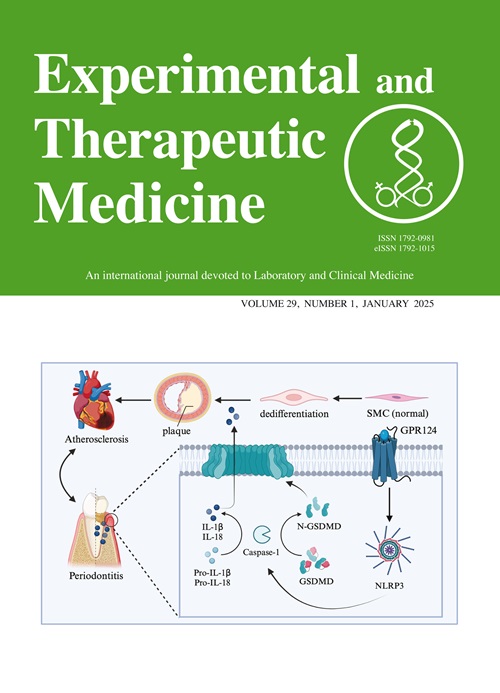Investigating the combinatorial effects of radiofrequency ablation and anticoagulants in patients with atrial fibrillation and left atrial appendage thrombosis after successful thrombolysis.
IF 2.3
4区 医学
Q3 MEDICINE, RESEARCH & EXPERIMENTAL
引用次数: 0
Abstract
The present study investigated the synergistic effects of radiofrequency ablation and various anticoagulants on adverse outcomes in patients with atrial fibrillation (AF) and left atrial appendage thrombosis following successful thrombolysis. Patients diagnosed with AF and left atrial appendage thrombosis post-successful thrombolysis (n=92) were retrospectively analysed. They were divided into two groups: Group A received radiofrequency ablation combined with an anticoagulant, while Group B received an anticoagulant alone and in combination with antiarrhythmic drugs. Subgroup analyses were conducted based on left atrial diameter (>45 mm), duration of AF (>1 year) and types of anticoagulants. Univariate and multivariate logistic regression analyses were performed to assess stroke and mortality risks in patients with AF with left atrial appendage thrombosis after dissolution. Multivariate logistic regression analysis identified AF duration (>1 year), left atrial diameter (>45 mm) and BNP level as significant risk factors for stroke (P<0.05). Compared with NOACs, the traditional anticoagulants (warfarin) demonstrated higher survival rates and lower stroke incidence in Group B (P<0.05); however, no significant difference was observed within Group A (P>0.05). Radiofrequency ablation combined with anticoagulants appeared to be more effective in treating AF with left atrial appendage thrombosis post-dissolution compared with anticoagulants alone. Attention to AF duration and left atrial diameter is crucial during early patient management. However, the choice between warfarin or NOACs for patients with AF and left atrial appendage thrombosis warrants further investigation.研究射频消融和抗凝剂对成功溶栓后心房颤动和左心房阑尾血栓形成患者的联合作用。
本研究调查了射频消融和各种抗凝药物对成功溶栓后心房颤动(房颤)和左心房阑尾血栓形成患者不良预后的协同作用。对成功溶栓后确诊为房颤和左心房阑尾血栓形成的患者(92 人)进行了回顾性分析。他们被分为两组:A 组接受射频消融术并联合使用抗凝剂,B 组单独或联合使用抗心律失常药物。根据左心房直径(>45 毫米)、房颤持续时间(>1 年)和抗凝药物类型进行了分组分析。对左心房阑尾血栓溶解后的房颤患者进行了单变量和多变量逻辑回归分析,以评估中风和死亡风险。多变量逻辑回归分析发现,房颤持续时间(>1 年)、左心房直径(>45 毫米)和 BNP 水平是卒中的重要风险因素(P0.05)。与单独使用抗凝药物相比,射频消融联合抗凝药物治疗房颤伴左心房阑尾血栓溶解后似乎更有效。在早期患者管理中,关注房颤持续时间和左心房直径至关重要。不过,对于房颤合并左心房阑尾血栓患者,选择华法林还是 NOACs 还需要进一步研究。
本文章由计算机程序翻译,如有差异,请以英文原文为准。
求助全文
约1分钟内获得全文
求助全文
来源期刊

Experimental and therapeutic medicine
MEDICINE, RESEARCH & EXPERIMENTAL-
CiteScore
1.50
自引率
0.00%
发文量
570
审稿时长
1 months
期刊介绍:
 求助内容:
求助内容: 应助结果提醒方式:
应助结果提醒方式:


